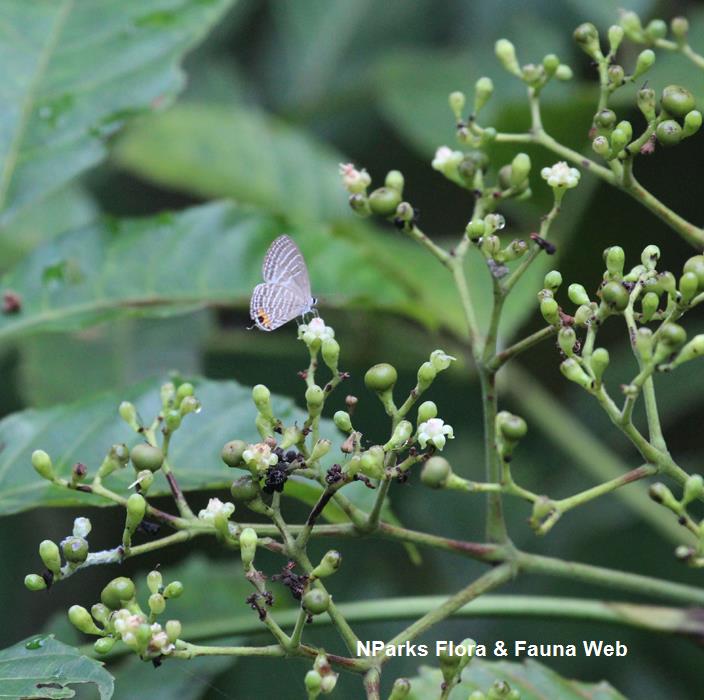
Back
Leea guineensis G. Don
| Family Name: | Vitaceae |
| Synonyms: | Leea manillensis Walpers. |
| Common Name: | West Indian Holly, 台湾火筒树 |
Name
Classifications and Characteristics
| Plant Division | Angiosperms (Flowering Seed Plants) (Dicotyledon) |
|---|---|
| Plant Growth Form | Tree, Shrub |
| Lifespan (in Singapore) | Perennial |
| Mode of Nutrition | Autotrophic |
| Plant Shape | Irregular |
Biogeography
| Native Distribution | Tropical Africa, Madagascar, India, Myanmar and South East Asia. |
|---|---|
| Native Habitat | Terrestrial (Primary Rainforest, Secondary Rainforest, Grassland / Savannah/ Scrubland) |
| Preferred Climate Zone | Tropical |
| Local Conservation Status | Non-native (Horticultural / Cultivated Only) |
Description and Ethnobotany
| Growth Form | A tree, it can grow up to 10 m in height and can be cultivated as a shrub. |
|---|---|
| Foliage | The leaves are pinnately compound and have obovate stipules. The young leaves are reddish-green in colour and turn to green as the leaves mature. The leaflets are elliptic to lance shaped and have a rounded base with a caudate apex and a dentate margin. |
| Flowers | The flowers are borne on a cyme and are red to reddish-orange in colour. |
| Fruit | The fruit come in the form of red berries when mature. |
| Habitat | It grows in forests and shrublands in its native range. |
| Associated Fauna | Its flowers are pollinated by insects and butterflies. Fruits are eaten by birds. |
| Cultivation | It can be propagated by seed or stem cutting. |
| Etymology | Latin Leea, a name for tropical small trees or shrubs named for James Lee (1715–1795), who was a nurseryman; Latin guineensis, from West Africa (Guinea Coast), referring to one of the countries within its natural distribution range. |
Landscaping Features
| Landscaping | It is suitable for landscaping in gardens and parks. |
|---|---|
| Desirable Plant Features | Ornamental Flowers |
| Landscape Uses | Parks & Gardens, Small Gardens |
Fauna, Pollination and Dispersal
| Fauna Pollination Dispersal Associated Fauna | Bird-Attracting, Butterfly-Attracting |
|---|---|
| Pollination Method(s) | Biotic (Fauna) |
| Seed or Spore Dispersal | Biotic (Fauna) |
Plant Care and Propagation
| Light Preference | Full Sun |
|---|---|
| Water Preference | Moderate Water |
| Plant Growth Rate | Moderate |
| Rootzone Tolerance | Moist Soils, Well-Drained Soils, Fertile Loamy Soils |
| Transplanting Tolerance | Good |
| Maintenance Requirements | Moderate |
| Propagation Method | Seed, Stem Cutting |
Foliar
| Foliage Retention | Evergreen |
|---|---|
| Mature Foliage Colour(s) | Green |
| Prominent Young Flush Colour(s) | Red |
| Foliar Type | Compound |
| Foliar Arrangement Along Stem | Opposite |
| Foliar Attachment to Stem | Petiolate |
| Foliar Shape(s) | Non-Palm Foliage (Lanceolate, Elliptical) |
| Foliar Venation | Pinnate / Net |
| Foliar Apex - Tip | Caudate |
| Foliar Base | Rounded / Obtuse |
Floral (Angiosperm)
| Flower & Plant Sexuality | Bisexual Flowers |
| Flower Colour(s) | Orange, Red |
|---|---|
| Flower Grouping | Cluster / Inflorescence |
| Flower Location | Axillary |
| Flower Symmetry | Radial |
| Inflorescence Type | Cyme |
Fruit, Seed and Spore
| Fruit Classification | Simple Fruit |
|---|---|
| Fruit Type | Fleshy Fruit , Non-Accessory Fruit |
Image Repository
Others
| Master ID | 30062 |
|---|---|
| Species ID | 4371 |
| Flora Disclaimer | The information in this website has been compiled from reliable sources, such as reference works on medicinal plants. It is not a substitute for medical advice or treatment and NParks does not purport to provide any medical advice. Readers should always consult his/her physician before using or consuming a plant for medicinal purposes. |









